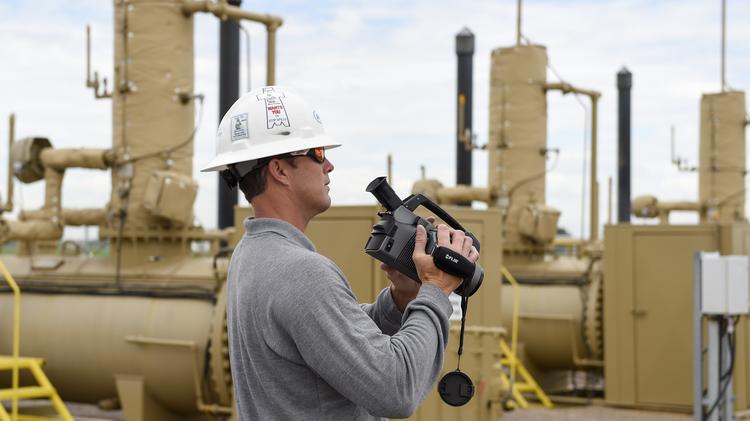EPA follows Colorado lead in targeting methane leaks from oil & gas
The U.S. Environmental Protection Agency
on Thursday finalized regulations cracking down on leaks of methane
from oil and gas operations across the country — a move Colorado made
two years ago.
Colorado
in 2014 approved the first regulations in the nation requiring energy
companies to routinely check their oil and natural gas wells — both new
and existing — statewide and fix equipment that is found to be leaking
methane, a potent greenhouse gas, into the atmosphere. The methane
that’s captured and kept in the system can be sold, reducing the net
cost of the regulations.
Colorado
regulations are “more protective” than what the EPA announced today,
although the EPA’s rules will affect far more wells since they’re
nationwide in scope, said Dan Grossman, Rocky Mountain regional director for the Environmental Defense Fund (EDF), which was involved in crafting Colorado’s rules.
Methane
is the second biggest source of greenhouse gas pollution in the United
States and nearly one-third of those emissions comes from oil production
and the production, transmission and distribution of natural gas,
according to the EPA.
Colorado’s
push to curb emissions of methane, which is 25 times more powerful as a
greenhouse gas than carbon dioxide, came after the EDF, a Washington,
D.C.-based advocacy group, joined with state regulators and three of
Colorado’s biggest oil and gas companies to craft the regulations. The
companies were Anadarko Petroleum Corp. (NYSE: APC), based in a Houston suburb, Noble Energy Inc. (NYSE: NBL), Encana Corp. (NYSE: ECA), based in Calgary, Alberta, Canada.
Recent field surveys by the Colorado Department of Public Health and Environment
(CDPHE) of oil and gas equipment found a 75 percent drop in the number
of sites where methane leaks were detected compared to similar surveys
prior to the regulations taking effect, said Will Allison, director of the department's Air Pollution Control Division.
"Colorado's rules are working extremely well," Allison said.
"We've
seen a significant decrease in the number of facilities where we're
seeing leaks, and we think that's a reflection that vigilance and
maintenance pays off, and that regular inspection of facilities that
have many components that can leak over time makes sense," he said.
"We also think it captures more product, which is a benefit to the environment and the industry as well," Allison said.
Grossman, with the EDF, said that Colorado’s regulations won’t be weakened by the EPA’s version.
“Today’s EPA rule today created a floor, not a ceiling,” he said.
“Colorado
will see little disruption in the way Colorado oil and gas operators
are doing their business, but nationally, today’s rules are
groundbreaking,” Grossman said.
Unlike
Colorado’s regulations, which cover all oil and gas wells and
associated equipment in the state, the regulations finalized by the EPA
on Thursday focus on new oil and gas wells, as well as those that are
modified or reconstructed. But the agency also said it’s starting the
process to crack down on methane leaks from existing wells in the
future.
It requires energy companies to check their equipment at least two times per year for leaks, and fix any that are found.
Colorado’s
rules also require routine checks, based on the size of the facility.
Big facilities, such as multi-well sites, must be checked once a month,
smaller ones must be checked once a quarter, and the smallest ones
checked once a year, Grossman said via an email.
Allison,
with the CDPHE, said Thursday afternoon that the agency was still
reviewing the complex rule and has questions about how Colorado can
demonstrate to the EPA that the 2014 rules meet or exceed the federal
agency's new rules.
"We'll
want to further explore the rule and how it might work with the EPA.
It's important that we reduce any duplication or inefficiencies that
might accrue with the implementation of the federal rules," Allison
said.
Allison
said he was glad to see that the EPA will allow operators to show that
new technology that comes along could be better than the existing
infra-red cameras that are currently used to conduct inspections. That
flexibility exists in Colorado's regulations and is a suggestion the
state made to the federal agency, he said.
EPA
Administrator Gina McCarthy said the agency’s new nationwide
regulations for methane leaks “will protect public health and reduce
pollution linked to cancer and other serious health effects while
allowing industry to continue to grow and provide a vital source of
energy for Americans across the country.”
They’re
part of President Barack Obama’s “Climate Action Plan” to cut methane
emissions, and its goal to reduce the 2012 level of methane pollution
from the oil and gas sector by 40 to 45 percent by 2025.
The
EPA said its regulations approved Thursday are expected to lead to the
capture of 510,000 short tons of methane in 2025, the equivalent of
reducing carbon emissions by 11 million metric tons.
The
EPA estimated that the cost of compliance nationwide will be about $530
million in 2025, but the value of the benefits will be $690 million.
Doug
Flanders, a spokesman for the Colorado Oil & Gas Association, an
industry trade group, said via email that the group is still reviewing
the 600-page document.
But
Flanders also noted Colorado’s regulations “provide equivalent or
greater benefits from an air quality perspective” compared to the EPA’s
new regulations, and that complying with both sets of regulations could
cause problems.
“Operators
have already spent significant resources to comply with Colorado’s
stringent program and shouldn’t be burdened with compliance with a
potentially redundant and conflicting program,” Flanders said.
“States
like Colorado are in the best position to regulate the industry, and
can account for unique characteristics, such as infrastructure – like we
have in the Denver-Julesburg Basin [north and east of Denver],” he
said.


No comments:
Post a Comment